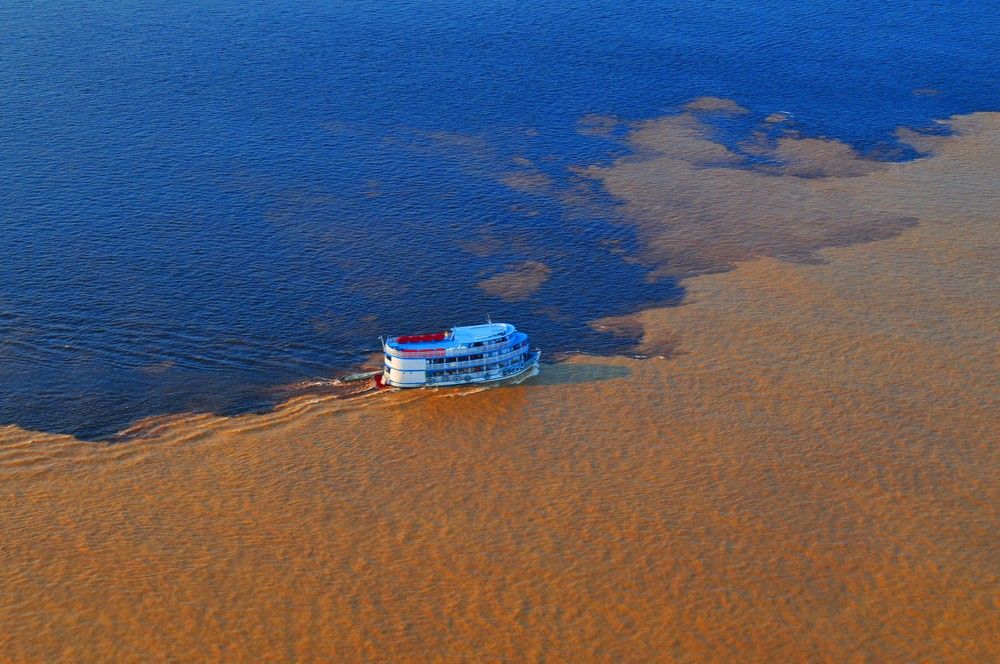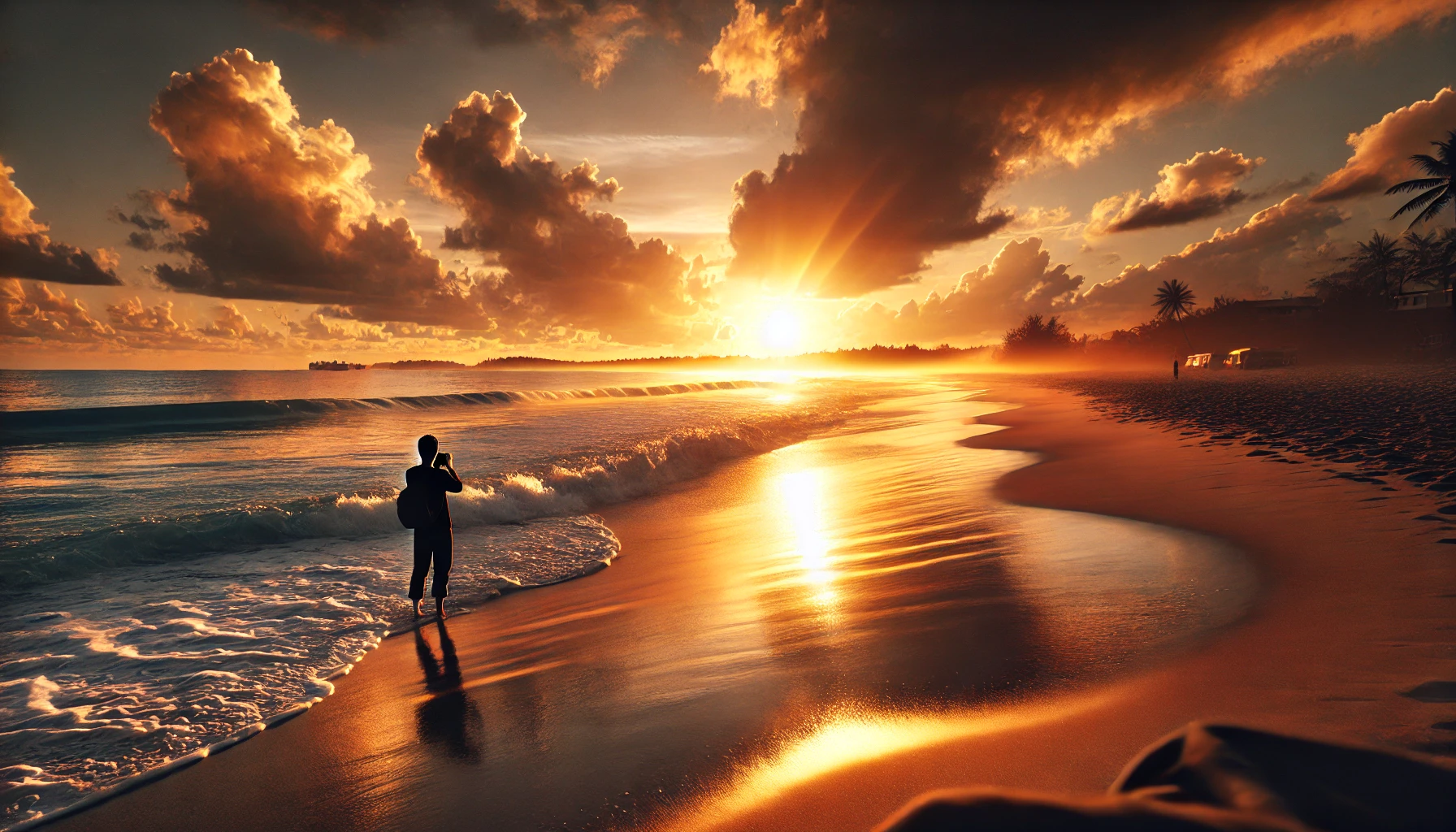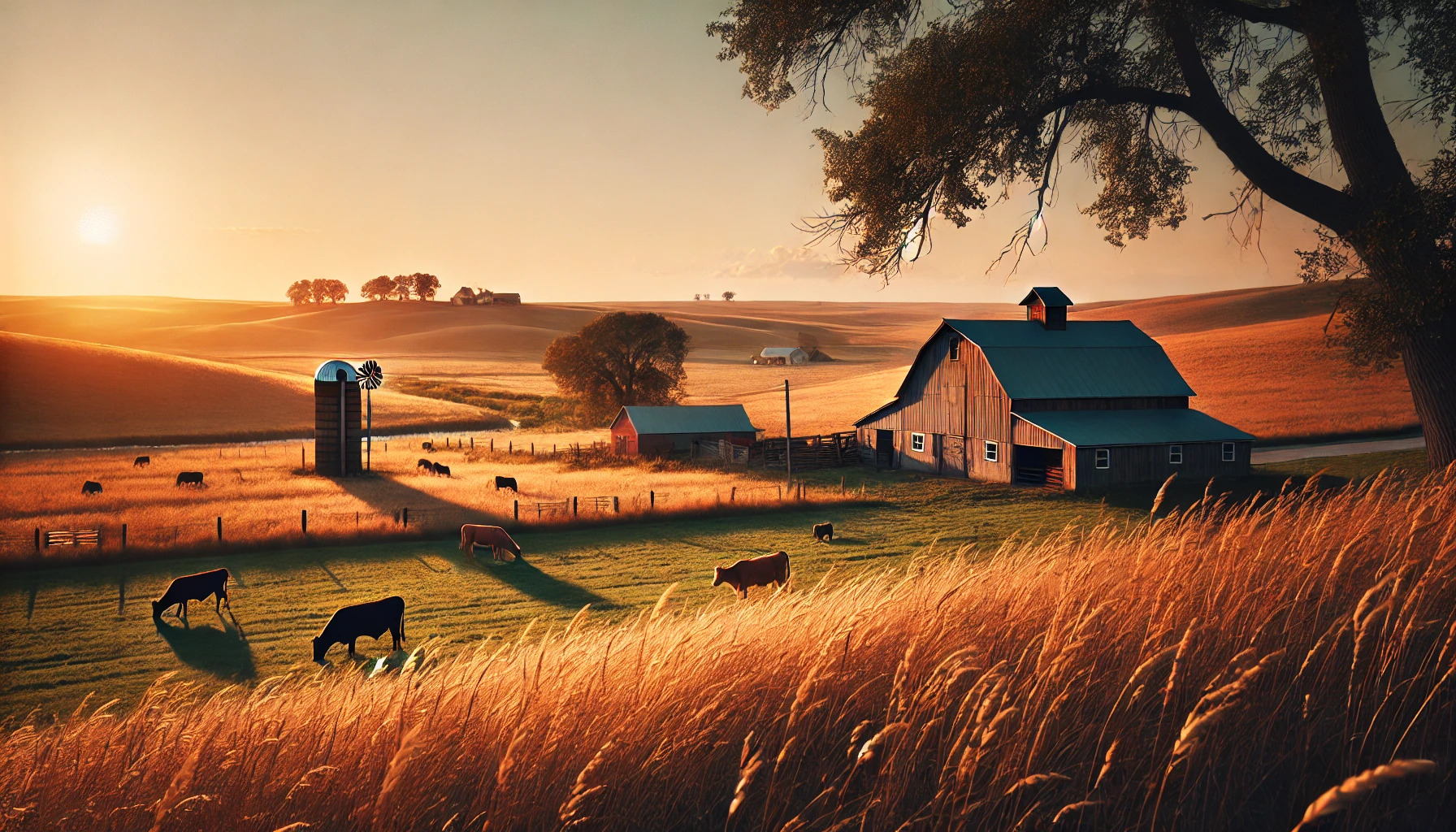The Meeting of the Waters is one of the most impressive natural phenomena in Brazil. Located at the confluence of the Negro and Solimões rivers, near the city of Manaus in the state of Amazonas, this spectacle attracts tourists from all over the world, amazed by the contrast between the dark waters of the Negro River and the muddy waters of the Solimões River, which flow side by side without mixing for several kilometers.
The Natural Phenomenon
The Meeting of the Waters occurs due to the physical and chemical differences between the two rivers. The Negro River has a dark coloration due to the high amount of decomposed organic matter and an average temperature of 28°C (82°F). The Solimões River, with its muddy color, carries a large amount of sediments and has a lower temperature, around 22°C (72°F). Additionally, the difference in current speeds contributes to the waters not mixing immediately, creating a spectacular visual effect.
Ecological Importance
This phenomenon is not just a visual spectacle but also plays a crucial role in the Amazonian ecosystem. The diversity in water temperature, flow speed, and chemical composition directly influences the region’s biodiversity. The meeting of these waters forms the Amazon River, the largest river in the world by water volume, which sustains an immense variety of fauna and flora.
Tourism and Experiences
The Meeting of the Waters is one of the main tourist attractions in Manaus. Visitors can explore this natural wonder through boat tours, offering a privileged view of the phenomenon and the opportunity to feel the temperature difference by touching the waters of both rivers. Additionally, many excursions include visits to riverside communities, rainforest tours, and wildlife observation, such as the pink river dolphins.
Best Time to Visit
The Meeting of the Waters can be visited year-round, but the months between July and November, when water levels are lower, offer a better view of the phenomenon. During this period, the river colors are more distinct, making the experience even more impactful.
Conclusion
The Meeting of the Waters is one of Brazil’s most fascinating natural wonders and a must-visit destination for anyone traveling to the Amazon. Beyond the unique beauty of the phenomenon, the region offers an immersion into the ecological and cultural richness of the Amazon rainforest, providing an unforgettable experience for tourists and researchers alike.

Mirante Serra da Jacirana: A Paradise in Northern Brazil
Mirante Serra da Jacirana is located in the state of Roraima, in the far north of Brazil, and is one of the most stunning and least explored destinations in this region. The site is known for its breathtaking view of the surrounding mountains and hills, which are characteristic of the Amazon landscape. With its rich biodiversity and striking scenery, Mirante Serra da Jacirana is attracting adventurous tourists who seek a unique experience in the heart of nature.
Location and Access
Mirante Serra da Jacirana is situated in the municipality of Caracaraí, approximately 100 km from the state capital Boa Vista, and is part of a more remote area in Roraima. To reach the mirante, visitors must travel on dirt roads, requiring suitable vehicles like 4x4s due to the terrain, especially during the rainy season. The journey itself is an adventure, leading travelers through vast landscapes of dense forests and challenging mountain roads.
The Stunning View
The main attraction of Mirante Serra da Jacirana is undoubtedly the panoramic view it offers. Located at the top of a hill, the mirante provides a privileged view of the vast Amazon rainforest and the surrounding mountains. From this elevated point, visitors can see a mix of dense vegetation and areas of high-altitude fields, creating a breathtaking landscape, with the mountains in the background forming an impressive horizon line.
The site is also ideal for wildlife and plant observation, as the region is rich in biodiversity. During the morning and evening, the sunlight creates a natural color spectacle in the sky and vegetation, making the mirante an excellent spot for those seeking moments of contemplation.
Biodiversity and Ecosystem
The area where Mirante Serra da Jacirana is located is rich in Amazonian and Cerrado fauna and flora, forming a unique ecosystem that combines characteristics of both regions. Visitors may spot various species of birds, such as toucans and macaws, as well as mammals like the howler monkey and jaguar, in their natural habitat.
The predominant vegetation in the region is tropical rainforest, with large trees such as Brazil nut trees and Samaúma, as well as a rich undergrowth that serves as food for several animal species. The site also features high-altitude fields and areas with Cerrado vegetation, making the ecosystem even more diverse.
Tourism and Environmental Awareness
Although Mirante Serra da Jacirana is not yet a widely known tourist destination, it is drawing a growing number of visitors interested in ecotourism and adventure in lesser-explored areas. Tourism in the region is controlled, which helps preserve the environment and the integrity of the site. On certain occasions, local guides lead visitors, promoting sustainable tourism and raising awareness about the importance of nature conservation.
Local communities are also involved in ecotourism initiatives, providing a more authentic experience for tourists while simultaneously benefiting the local economy. Additionally, environmental conservation efforts are crucial, as the area lies in a sensitive part of the Amazon.
Conclusion
Mirante Serra da Jacirana in Roraima is a spectacular destination for nature lovers and adventure tourists. Its remote location, immersion in a unique ecosystem, and panoramic views are enough to attract those seeking an authentic experience in northern Brazil. Through responsible and sustainable tourism, the mirante and its region can continue to be preserved, ensuring that future generations can also be captivated by its natural beauty. If you’re looking for an unforgettable place to explore, Mirante Serra da Jacirana is undoubtedly one of Brazil’s hidden gems.

Morro da Piraóca: A Strategic Landmark in the Northern Region
Morro da Piraóca, located in the northern region of Brazil, is one of the most impressive natural landmarks of the area. With a rich history and significant value for both locals and visitors, this hill serves as an example of how nature can shape the landscape and culture of a region. Let’s explore its characteristics, history, and importance.
Geographic Location
Morro da Piraóca is located in the northern region of Brazil, in a state of great biodiversity and environmental significance. Its strategic position offers a panoramic view of various surrounding areas, making it a reference point for locals and tourists alike. The region around the hill is known for its lush vegetation and rich ecosystems, making it an attraction for eco-tourists as well as nature researchers.
History and Cultural Significance
The name “Piraóca” originates from indigenous words, reflecting the strong presence and influence of native cultures in the area. The term may have various interpretations depending on the linguistic context but is generally associated with elements of nature, such as animals and plants typical of the region.
Historically, Morro da Piraóca served as an important observation point, acting as a landmark for navigation and early expeditions in the area. Over the years, it has become a symbol of resistance and environmental preservation, standing out as an important site for the local community and the history of the northern people.
Flora and Fauna
The area around Morro da Piraóca is predominantly covered by tropical rainforest, with large trees and a wide range of endemic species. Furthermore, the hill is rich in wildlife, hosting various bird species, mammals, and insects that contribute to the biological diversity of the region. The hill is also a prime spot for birdwatching, attracting many biologists and nature enthusiasts.
Ecological Importance
Morro da Piraóca, like other geographical formations in the northern region, plays a crucial role in maintaining the ecological balance of the area. Besides being a place of great scenic beauty, the hill helps regulate the local climate and contributes to the conservation of biodiversity. Its preservation is essential for maintaining the ecosystems that depend on its unique characteristics.
Tourist Attraction
With its natural beauty and historical value, Morro da Piraóca has become an important tourist destination. Access to the hill is typically made via hiking trails, offering visitors an immersive experience in nature. During the hike, it is possible to observe local wildlife and flora, as well as enjoy the spectacular view from the hilltop.
The region is also known for the hospitality of its inhabitants, who welcome tourists with local culture, traditional cuisine, and an authentic perspective on life in the northern region. Ecotourism is one of the most sustainable ways to explore Morro da Piraóca, allowing visitors to appreciate the site without harming the environment.
Conclusion
Morro da Piraóca is not just a geographically significant landmark but also a symbol of resistance, history, and environmental preservation. Its importance to the northern region goes beyond the landscape, being closely tied to culture and environmental conservation. For nature and history enthusiasts, a visit to Morro da Piraóca is a unique opportunity to learn more about the natural and cultural wealth of Brazil.
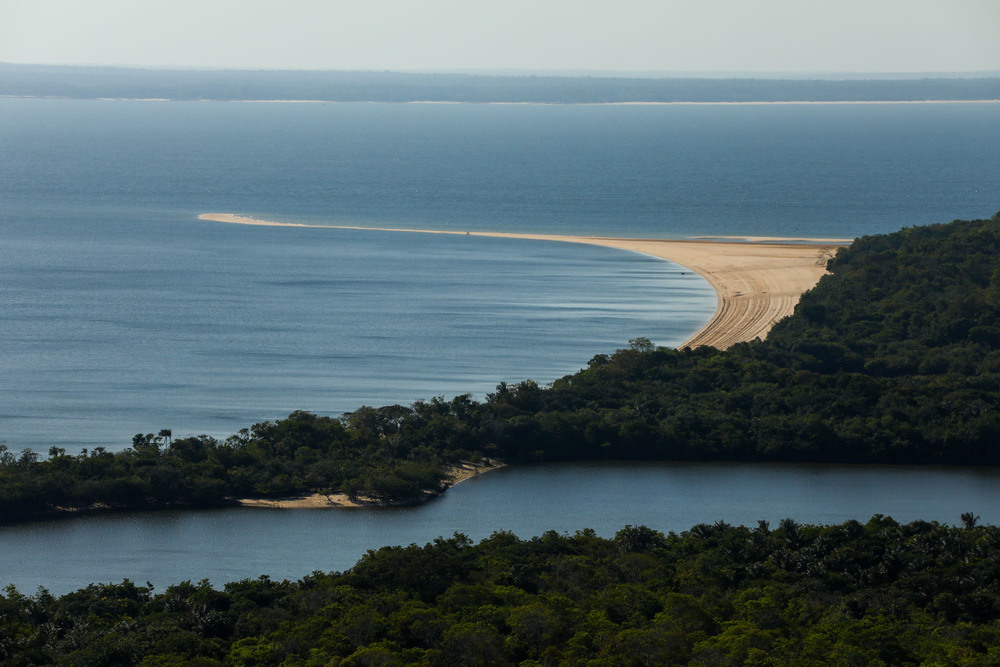
Jalapão: The Natural Paradise of Tocantins
Jalapão, located in the state of Tocantins in northern Brazil, is one of the most impressive and preserved natural areas in the country. Known for its breathtaking landscapes, with golden sand dunes, crystal-clear fervedouros (boiling springs), and lush waterfalls, Jalapão stands out as a destination for nature lovers and ecotourism enthusiasts. Let’s explore what makes this place so unique and special.
Location and Access
Jalapão is located in the central part of Tocantins, covering an area of approximately 34,000 km². Access to the Jalapão State Park, which covers much of the region, is primarily via dirt roads, requiring suitable transportation such as 4×4 vehicles. Despite the challenging journey, the reward is immense, with untamed and untouched landscapes that attract tourists seeking adventure and a deep connection with nature.
Natural Features
One of the main features of Jalapão is its diversity of landscapes. Among the most famous natural beauties are the imposing golden sand dunes, which stretch for kilometers, and the fervedouros—sources of crystal-clear water that bubble up due to underground water pressure. These natural formations are unique in the world and make the region a true ecological paradise.
Moreover, Jalapão is home to rich biodiversity, with various species of fauna and flora typical of the Caatinga and Cerrado biomes, two of the predominant ecosystems in the region. The vegetation is mostly composed of grasslands, cerrado (savanna), and small areas of forests, creating an impressive and varied landscape.
Must-See Attractions
Jalapão is full of natural attractions of great beauty. Some of the most famous include:
- Jalapão Dunes: One of the region’s postcards, the golden sand dunes are shaped by the wind and reach heights of up to 40 meters. The view from the top of the dunes is breathtaking, with an expansive landscape around.
- Fervedouros: Fervedouros are crystal-clear water springs, where the pressure from underground water creates a phenomenon that makes the water bubble without flowing, causing people to float on the surface. Some of the most famous fervedouros are Fervedouro do Ceiça and Fervedouro do Alecrim.
- Cachoeira da Formiga (Ant Waterfall): One of the most beautiful in the region, Cachoeira da Formiga features an impressive waterfall and a natural pool where visitors can refresh themselves.
- Serra do Espírito Santo: One of the best spots to contemplate the landscape of Jalapão, Serra do Espírito Santo offers a panoramic view of the region and is the ideal place for watching the sunset over the dune desert.
- Prainha do Rio Novo (Little Beach on the Rio Novo): One of the rare freshwater beaches in Brazil, Prainha do Rio Novo offers an incredible setting, with crystal-clear waters and white sand, perfect for relaxing and taking a refreshing swim.
Local Culture
Jalapão is also rich in culture, with various traditional communities living in the region, such as indigenous peoples and quilombolas (descendants of escaped slaves). These communities preserve traditional and sustainable lifestyles, often using natural resources carefully to ensure environmental preservation.
Additionally, the local culture is reflected in the cuisine, with typical dishes that make use of regional ingredients, such as pequi (a native fruit), rice with pequi, and delicious fruits typical of the Cerrado. Visitors have the opportunity to learn about and experience this culture during their trips to Jalapão.
Sustainable Tourism
One of the key features of Jalapão is its sustainable ecotourism. The area preserves its untouched nature, allowing visitors to enjoy its beauty without causing significant environmental damage. The activities in Jalapão are mostly related to adventure tourism, such as hiking, walking trails, and visits to natural attractions.
Tourism in Jalapão has been essential for the preservation of the region, promoting environmental conservation practices and supporting local communities, who find in tourism an important source of income, always focusing on respecting nature.
Challenges and Conservation
Although Jalapão is a relatively preserved area, it faces some challenges, such as the increasing pressure from tourism and the need to maintain the balance between economic development and environmental conservation. The lack of infrastructure in some areas and the rising number of visitors require continuous efforts to ensure that ecotourism remains a sustainable practice in the region.
Conclusion
Jalapão is one of Brazil’s most fascinating destinations, with landscapes that impress with their natural beauty and uniqueness. With its golden dunes, crystal-clear fervedouros, and rich biodiversity, the region stands out as a true ecological paradise. By visiting Jalapão, tourists have the opportunity to experience nature in a unique way while contributing to the preservation of one of Brazil’s most important ecosystems. The combination of adventure, local culture, and environmental preservation makes Jalapão an unmissable destination for nature lovers and ecotourism enthusiasts.
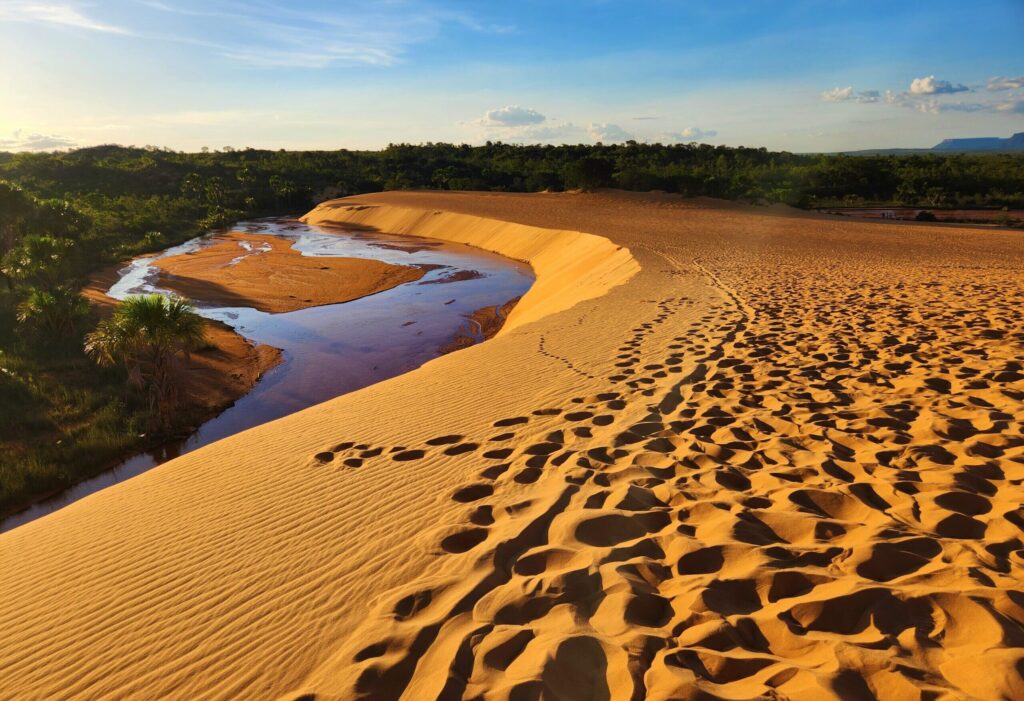
Other most photographed destinations in the North of Brazil
The North Region of Brazil is known for its exuberant biodiversity, stunning natural landscapes, and rich cultural heritage. It is home to some of the country’s most impressive natural and architectural beauties, attracting tourists from all over the world. Among the most visited and photographed places in the region are imposing rivers, paradisiacal beaches, and historic monuments. Below, we highlight some of the most iconic destinations in Northern Brazil.
Anavilhanas Archipelago
Located in the state of Amazonas, the Anavilhanas Archipelago is one of the largest groups of river islands in the world. This vast archipelago, situated on the Rio Negro, consists of over 400 islands, offering an impressive and paradise-like setting. The place is known for its calm waters, rich fauna and flora, and is an excellent destination for ecotourism, birdwatching, and activities such as trekking and boat tours. The landscapes filled with tropical vegetation and direct contact with nature make this archipelago one of the most photographed places in Northern Brazil.
Marajó Island
Marajó Island, located in the state of Pará, is the largest river island in the world and a prominent tourist destination. With its mix of beaches, fields, and forests, the island captivates visitors with its rustic charm and breathtaking landscapes. In addition to its natural beauty, the island is famous for its unique culture, especially the influence of riverine communities and the buffaloes that are part of the local identity. Marajó’s beaches, such as Praia de Pesqueiro and Praia do Barra Velha, are frequented by tourists looking to relax and take beautiful photos with the exuberant scenery.
Ponta Negra Beach
Ponta Negra Beach is one of the most visited tourist destinations in Manaus, the capital of Amazonas. Located on the banks of the Rio Negro, the beach offers a spectacular view of the river and the surrounding landscapes. During the day, tourists and locals enjoy the sun and calm waters of the beach, while at night, the area turns into a vibrant meeting point with bars, restaurants, and live music. The sunset at Ponta Negra is one of the most photographed moments in the city, making it one of the iconic images of Manaus.
Basilica of Nazareth
Located in Belém, in the state of Pará, the Basilica of Nazareth is one of the largest religious symbols in Brazil, famous for housing the image of Our Lady of Nazareth, the patroness of the state. The basilica, built in the neoclassical style, is a must-visit for those in the region, especially during the Círio de Nazaré, the largest religious festival in the state. The grand architecture and the cultural and religious significance of the basilica make it one of the most photographed and revered landmarks in Northern Brazil.
Museum of the Rubber Tree
In Manaus, the Museum of the Rubber Tree is an important historical landmark that preserves the memory of the rubber boom era, when latex extraction was responsible for the economic growth of the region. The museum is a true journey through time, with replicas of rubber plantations and typical buildings from the period, allowing visitors to experience the way of life of rubber tappers. The museum’s architecture and historical context make it an interesting spot for both history enthusiasts and those seeking a unique backdrop for photos.
Mount Roraima
Mount Roraima, located at the border between Brazil, Venezuela, and Guyana, is one of the most impressive destinations in Northern Brazil. Its unique geological formation and towering altitude make it one of the most visited and photographed tourist spots in the country. The famous “Mount Roraima Trek” is one of the most challenging and rewarding hiking routes, offering spectacular views and the chance to explore the rich biodiversity of the region. Mount Roraima is also known for being the inspiration for Sir Arthur Conan Doyle’s book The Lost World.
Alter do Chão Beach
Alter do Chão, located in the state of Pará, is a small fishing village known for its freshwater beaches and stunning landscapes. Alter do Chão Beach, considered one of the most beautiful beaches in Brazil, is famous for its white sand and crystal-clear waters. The location has become a popular destination for tourists looking to relax in a paradisiacal setting. The natural beauty and tranquility of Alter do Chão make it one of the most photographed places in Northern Brazil, attracting both national and international visitors.
Conclusion
The North Region of Brazil is a true paradise for nature, culture, and adventure lovers. The destinations mentioned, such as the Anavilhanas Archipelago, Marajó Island, Alter do Chão Beach, and Mount Roraima, are just a few examples of what this region has to offer. Whether you are seeking beautiful natural landscapes, fascinating culture, or moments of contemplation, these destinations stand out for their unique beauty and are the perfect backdrops for unforgettable photos. Each of these places carries a part of the rich diversity and authenticity that make the North Region of Brazil one of the most fascinating destinations in the country.

